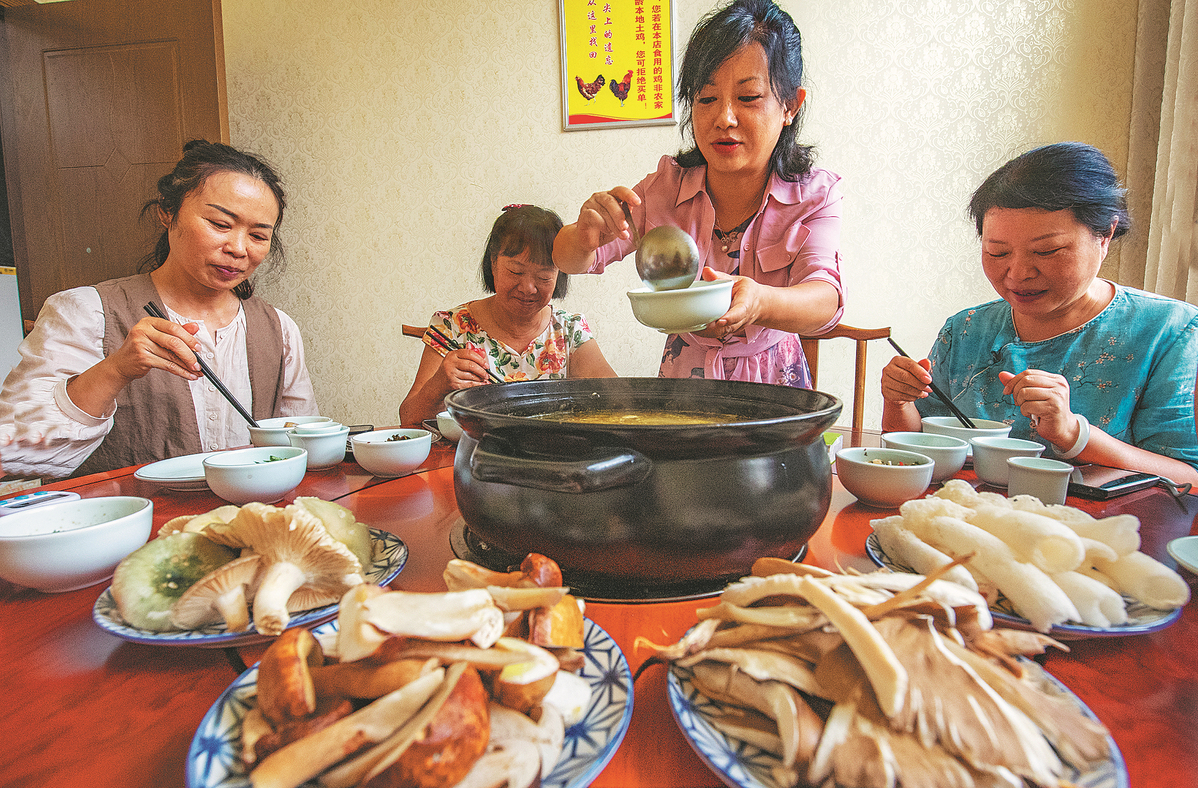Youth take a shine to no-frills hotpot
Businesses develop sub-brands, cut prices, provide free add-ons, or launch affordable set menus to attract Gen Z customers


China's catering sector has witnessed fierce competition over the past few years, especially in the niche hotpot segment, with local hotpot businesses adopting a string of strategies of late to better attract customers.
These include lowering product prices and tapping into so-called "sinking markets" — mostly third or fourth-tier cities.
In 2023, 75,000 new hotpot businesses were set up in the country, a report by market research firm New Catering Big Data showed.
At a Xiaohai Hotpot restaurant in Chaoyang district of Beijing, customers are lining up for an inexpensive, yet tasty meal.
Though it was set up in September 2023, Xiaohai — a sub-brand of renowned hotpot chain Haidilao — has quickly turned popular among students and new workers, due to its cost advantage. Xiaohai sells food that is nearly 50 percent cheaper than at Haidilao.
Customers can get a hotpot broth for 9.9 yuan ($1.39) and a plate of beef for 23.9 yuan.
Zhang Ying, a college student from Chaoyang district, told China Daily that she and her friends are frequent diners at the low-priced chain.
"I'm a huge fan of Haidilao, but it's a bit pricey for a college student like me. Besides, Haidilao's student discounts are only available during certain times of the day," the 20-year-old said.
"That's why I was very excited when a Xiaohai outlet opened near my college. The food tastes similar to Haidilao, but is priced much lower. Now, I can have delicious hotpot whenever I want," Zhang added.
A spokesman for Xiaohai Hotpot said one of the key reasons why Haidilao created the subbrand was to better tap into the consumption potential of Generation Z, or those born during the late 1990s to early 2000s.
Gen Z's consumption accounts for a relatively low proportion of China's total, but their willingness to consume is much higher than that of any other generation, he said.
" … By creating Xiaohai, we expect to provide young people with more consumption options and allow them to enjoy the happiness of dining out at low costs," he added.
In addition to developing low-priced subbrands, most hotpot businesses have chosen to directly reduce prices of their dishes, provide free snacks and fruits, or launch affordable set menus on e-commerce platforms such as Meituan and Dazhongdianping.
Xiabu Xiabu, for instance, lowered its prices by more than 10 percent in May, with the average consumption per customer not exceeding 60 yuan. The large hotpot chain also created a variety of "worker's set menus" priced at about 50 yuan, which are only available on weekdays.
Nan Hotpot, a brand that used to focus on middle and high-end consumers, recently changed its business strategy and announced a plan to cut product prices by nearly half.
Chen Hanzhao, a white-collar worker from Changping district of Beijing, said Xiabu Xiabu's new set menu has become one of his favorite weekday lunch choices.
The set menu usually includes vegetables, meat, noodles and drinks, and the serving is just enough for one person.
"In the past, I didn't really like eating at such restaurants, because hotpot does not require superb cooking skills. I could make it myself at home and spend less," said Chen.
" … But after Xiabu Xiabu launched the affordable set menu, I often go there for lunch because it saves me a lot of time," he said.
However, there is still some room for improvement, he added.
"In order to increase the number of dishes in the set menu, the hotpot restaurants always add something that is not very popular with the public … My colleagues and I never eat them, which is really a waste," Chen said.
"Besides, I am a little worried about the food quality, because the price of hotpot is dropping too fast. I really hope the store owners will not overlook this," he added.
Meanwhile, as the hotpot market in China's first-tier cities — such as Beijing and Shanghai — reaches a saturation point, some brands have chosen to set their sights on third or fourth-tier cities.
Data from the National Bureau of Statistics showed that third and lower-tier cities are currently home to more than 77.55 percent of China's urban population, which demonstrates a huge market potential.
Since such cities have cheaper land and abundant human resources, it is easier for hotpot brands to cut operating costs and survive over the long run.
For example, Xiaohai Hotpot is actively expanding into the so-called "sinking markets". The brand has already opened restaurants in several provinces such as Hebei and Zhejiang, its spokesman said.
Experts said the recent initiatives taken by hotpot brands could serve as the driving force for China's economic growth in the short run, even as further efforts are needed from all parties in the sector.
Lin Shen, an associate research fellow at the Institute of World Economics and Politics of the Chinese Academy of Social Sciences, said hotpot brands could stimulate the country's consumption if they reduce product prices.
Lin said the affordable set menus launched by some restaurants are a good example. They perfectly match the needs of individual consumers in a fast-paced life, and have thereby successfully caught their eyes.
"Meanwhile, compared to other sections of the catering industry, hotpot brands have lower labor costs, as there is normally no need to hire professional chefs. That's why price cuts won't hurt the brands' profits too much," said Lin.
"Of course, it is also important to avoid excessive price cuts, which will not only result in a waste of investment and resources, but also have an adverse effect on food suppliers and employees."
Lin also said hotpot brands must keep a close eye on quality during the process of price cutting.
"In recent years, there have been reports that some hotpot restaurants are passing off duck meat as beef and mutton. The restaurants must strive to build a better brand reputation, and the market supervision departments need to further step up law enforcement," Lin said, while lauding the brands' expansion into third and fourth-tier cities.
"Such moves can significantly reduce vicious competition among hotpot restaurants in first-tier cities, especially in their central business districts," he said.
He also expects the expansion to better empower China's rural vitalization, as they could become important consumers of livestock and vegetable farming products in China's third and lower-tier cities.
Besides, the brands should follow the example of China's milk tea beverage sector and gradually shift their focus to global markets, he added.
Zhou Mi, a researcher at the Beijing-based Chinese Academy of International Trade and Economic Cooperation, said there are two major reasons why so many people in the country are planning to start a hotpot business.
"While on the one hand, hotpot does not require deep processing and is relatively simpler to make, on the other, the price of raw materials, especially meat, has remained at a low level in recent years," said Zhou.
Cutting prices can temporarily help hotpot brands survive amid fierce competition, but if they want to grow further, they must intensify their efforts in other areas, he said.
For example, many consumers enjoy hotpot not so much for the food itself, but to spend happy moments together with family and friends. Therefore, hotpot restaurants that provide a cozy and lively atmosphere will be more popular, Zhou said.
Chen Xinhua, president of China Hospitality Association, said in an earlier interview that the high-quality development of China's catering industry relies heavily on innovation. Local restaurants should strive to develop new business strategies and products, as well as actively utilize emerging technologies.
Chen said such moves could help restaurants effectively address the "pain points" encountered during transformation, and thereby better adapt to the rapidly changing market environment. The industry's overall profitability is also expected to be further improved as innovation continues to deepen.
Zheng Yiran contributed to this story.
liuzizheng@chinadaily.com.cn





































